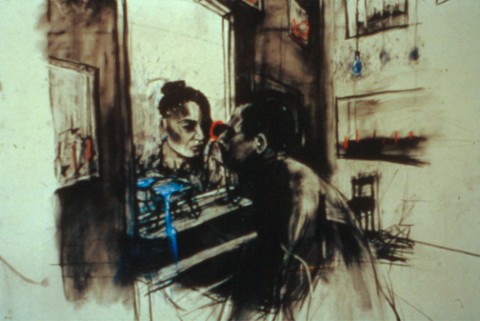South African artist William Kentridge gained the attention of the art world in the 1990s with short, haunting, animated films based on charcoal drawings about his homeland. Born in Johannesburg to a politically engaged and culturally sensitive family for whom the violence, tension, inequities, and contradictions of the apartheid era were deeply felt and considered, Kentridge has made not only films but also prints, drawings, artist books, collages, performances, and even operas that are both personal and political. Living in Johannesburg in the 1970s, he studied politics and African Studies at the University of the Witwatersrand (1973–76), founded a nonracial theater, and taught painting, drawing, and prints at an art school. In the 1980s he spent several years in Paris studying mime and theater and then returned to Johannesburg—where he lives and works today—and started a filmmakers cooperative.
By the 1990s Kentridge had begun making the films for which he is best known. Two of these are based on the Truth and Reconciliation Commission, which was established in post-apartheid South Africa after the country’s first democratic election in 1994. The hearings elicited extraordinary acts of confession and forgiveness, themes that Kentridge has woven into his films. In Ubu Tells the Truth (1997), a dark and garbled soundtrack is combined with violent drawings—of a black and a white animal facing off, of a man in freefall—and archival footage of police actions in order to reference the epic tragedy of apartheid and its aftermath. Shadow Procession (1997) is more hopeful. It employs animated puppets and torn paper to create an anonymous line of people who slowly march through a barren landscape to the somber yet uplifting sounds of traditional South African music. The film portrays the heavy figures with dignity and resilience.
Other films by Kentridge, like the nine-minute Felix in Exile (1994), examine survival in post-apartheid South Africa from a more personal perspective. Kentridge developed Felix using his now signature technique of animating photographs of charcoal drawings. Working without a storyboard, he drew on a single sheet of paper pinned to the wall and took photos throughout many stages of adjustments until he had completed forty drawings, each corresponding to a scene. The resulting photos were animated into a sequence in which visual elements—people, chairs, hills—are built up and erased but never fully disappear. The remaining charcoal smudges provide a link to the artist’s process and convey the idea that memories may fade, but they never go away. Felix is the fifth film in a larger body of work that includes nine films and a number of prints. In it the title character, a surrogate for the artist, tries to understand his beautiful, sorrowful homeland from afar. He does so through drawings made by another character whose observations—of death in the streets, burnt land, star-studded skies—magically appear in Felix’s distant quarters. At the film’s conclusion Felix is back home in a decimated, bleeding landscape that is nonetheless beginning to nurture life. The film, which has a soaring, mournful score, is representative of Kentridge’s work as a whole. Both personal and political, it suggests that art is central to keeping memories alive and to fostering growth, even in the presence of unspeakable acts of injustice. —Kate Green

